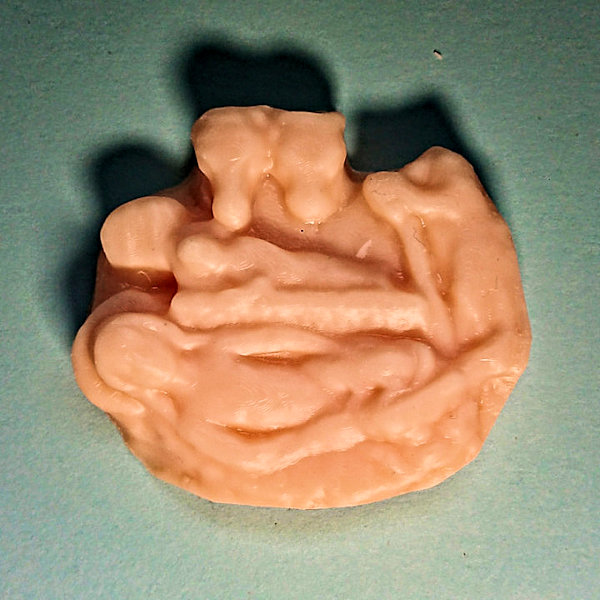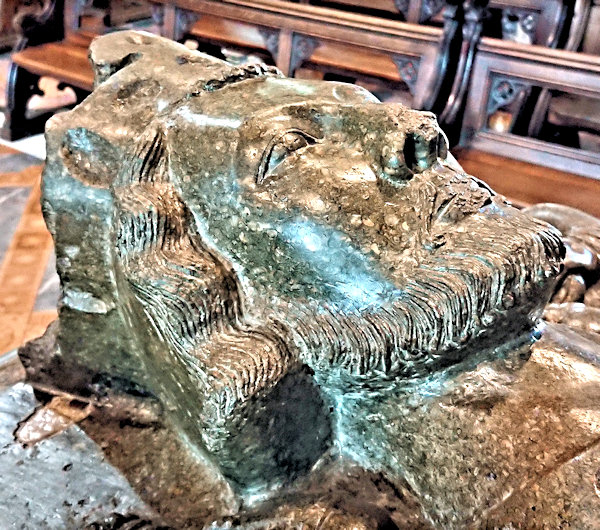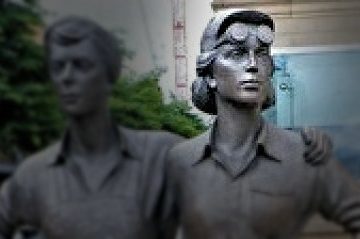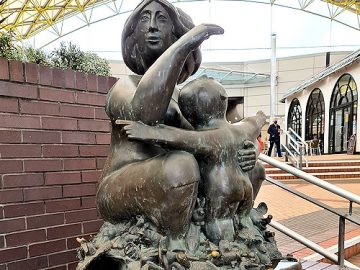Pilgrimage is most likely as old as faith itself. And for Christians, it has been going on for as long as the years since Jesus Christ ascended to Heaven. So when abbeys and cathedrals started to appear in England during the Middle Ages, they obviously created a focal point for pilgrim visits, becoming points of note along pilgrimage routes. Often they even held relics from the Saints they held most dear. So, at 900 years old Tewkesbury Abbey, in Western England, must have seen many pilgrims in its time. And it’s still a popular destination for tourists and the faithful alike, which I think is just a modern version of pilgrimage. And just like modern pilgrims, the ones of old were also fond of collecting souvenirs of their visits (see The Becket Story to read more about pilgrim souvenirs). So, having visited Tewkesbury Abbey in February 2020, I decided to use one of the small, and very old, stone carvings leaning against a wall there as a way to create my own pilgrim souvenir.

Quick summary of this 3D creation
Overview: A basic scan of a stone carving in Tewkesbury Abbey.
Location: Tewkesbury Abbey, Tewkesbury, western England, United Kingdom [map].
Date/era: Unknown, possibly Medieval.
Software used: Sony 3DCreator Android app, Meshmixer.
Intended use: 3D printing, either in resin or fused filament, the latter being possible without any support material.
The scan was done with the Sony 3D Creator app on an Xperia XZ1 Compact smartphone. Fortunately, the carving was on the floor leaning at an angle against a wall, so it was easy to get to, and move the camera around, to get a complete scan. Using 3DCreator obviously means the scan doesn’t contain small details, largely because the carving has limited surface texture for use with photogrammetry scanning methods.
However, the original was quite eroded (presumably it was once located outdoors) so the amount of detail in it was already quite limited. So overall 3DCreator did do a very good job of representing the shape and form as a record of the carving for posterity. And, given that 3DCreator is provided free by Sony, and is easy and quick to use, I don’t really think I can complain, especially as the result was definitely good enough for me to make a nice pilgrim souvenir.
The scan was then post-processed using Meshmixer to remove extraneous areas and to remesh to a sensible file size for speed of use in the Sketchfab viewer, as well as to allow speedy downloads. The solidify tool was used for that, with the sharp edge preserving setting allowing a sensible file size with minimal loss of the limited detail contained in the original scan. If I’d done the scanning more recently, I think I would also have used Nomad Sculpt, before Meshmixer, as the pressure-sensitive tools (when used with a tablet computer with a pen/stylus) would allow for much better sharpening around the edges of features (using the crease tool with a small radius). You can see the finished model on Sketchfab below (click the play button to load the model and view it in 3D).
The example 3D print in the photo below was made using a Monoprice Mini SLA resin printer, using standard UV-curing resin, and I think it came out well despite being only 40mm wide. However, there are no sharp overhangs that would result in annoying removal of support material, when fused-filament printing, if the back is flat on the print bed. Therefore, resin printing isn’t really necessary for you to do a good 3D print. The main reason I preferred resin printing for this project is that I like having small prints of historic objects (and having a small home is a significant factor too). Regardless of your personal faith, Tewkesbury Abbey is an excellent destination for a day out so, if you decide to visit, maybe you can 3D print your own pilgrim souvenir too, using the 3D model documented here. If so, click here to go to the MyMiniFactory page to download it.

The print was later painted using Pebeo craft acrylics to give a stone effect, and then given a protective coat of matt varnish that has the added advantage of controlling shininess. Craft acrylics are quite thick, so they caused some loss of detail, although I won’t be viewing it very closely. Thinner paints (such as The Army Painter or Citadel ones) could have been a better option as resin layer lines are very fine and so easier to hide with thinner paints. Also, in combination with their wash mediums, they can be used to get some very nice stone effects (for example, see my scan of the pilgrim sculpture in Droitwich Spa). But overall I was quite pleased with the result, and I think it turned out well as a modern take on pilgrim souvenirs.
So finally, in case you’d like to use the methods in this project for your own work, let’s recap on what was involved:
- The Sony 3DCreator Android app was used to create a basic 3D scan on a smartphone, which provided a good representation, albeit with loss of detail on sharp edges.
- On a PC Meshmixer was used to tidy the 3D scan, including cutting away unwanted material, smoothing poorly scanned areas, and sharpening edges.
- Meshmixer was also used to solidify/remesh the model, to achieve a much smaller file size, using the sharp edge preserving setting to minimise loss of fine details.
- The finished 3D model was then test printed in resin and found to print to an acceptable quality, even at a small size.
- Due to the limited amount of detail in the final model, and the ability to print without support material, fused-filament 3D printing can also be considered a good option for larger prints.
Please note that this model is provided without any license for commercial use. It is intended simply as a historical model, and of course a modern pilgrim souvenir, you can have the fun of printing yourself. And of course it is intended to be a motivation for you to visit the beautiful Tewkesbury Abbey yourself: click here to see the location in Google Maps.




